check engine INFINITI QX50 2021 Manual PDF
[x] Cancel search | Manufacturer: INFINITI, Model Year: 2021, Model line: QX50, Model: INFINITI QX50 2021Pages: 542, PDF Size: 3.51 MB
Page 476 of 542
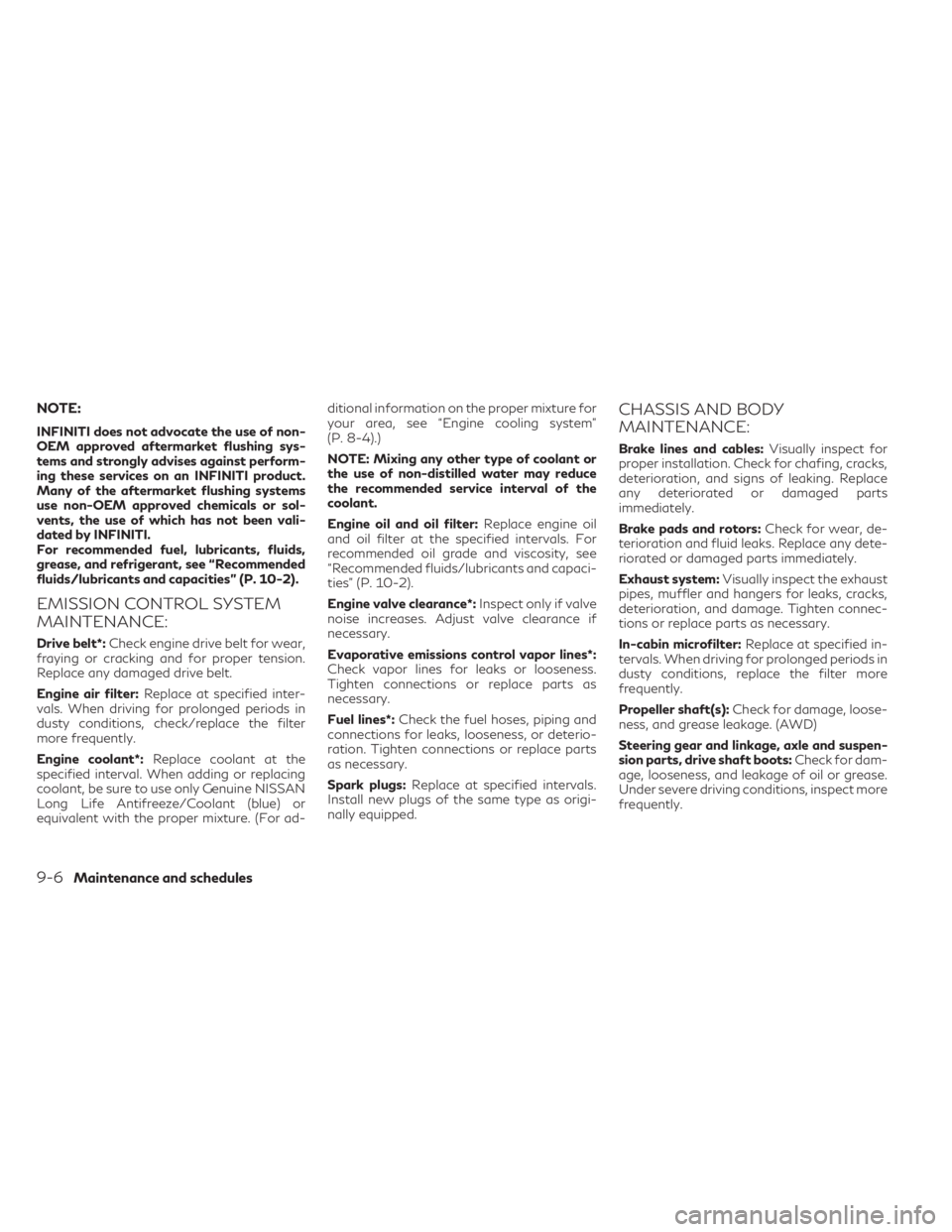
NOTE:
INFINITI does not advocate the use of non-
OEM approved aftermarket flushing sys-
tems and strongly advises against perform-
ing these services on an INFINITI product.
Many of the aftermarket flushing systems
use non-OEM approved chemicals or sol-
vents, the use of which has not been vali-
dated by INFINITI.
For recommended fuel, lubricants, fluids,
grease, and refrigerant, see “Recommended
fluids/lubricants and capacities” (P. 10-2).
EMISSION CONTROL SYSTEM
MAINTENANCE:
Drive belt*:Check engine drive belt for wear,
fraying or cracking and for proper tension.
Replace any damaged drive belt.
Engine air filter: Replace at specified inter-
vals. When driving for prolonged periods in
dusty conditions, check/replace the filter
more frequently.
Engine coolant*: Replace coolant at the
specified interval. When adding or replacing
coolant, be sure to use only Genuine NISSAN
Long Life Antifreeze/Coolant (blue) or
equivalent with the proper mixture. (For ad- ditional information on the proper mixture for
your area, see “Engine cooling system”
(P. 8-4).)
NOTE: Mixing any other type of coolant or
the use of non-distilled water may reduce
the recommended service interval of the
coolant.
Engine oil and oil filter:
Replace engine oil
and oil filter at the specified intervals. For
recommended oil grade and viscosity, see
“Recommended fluids/lubricants and capaci-
ties” (P. 10-2).
Engine valve clearance*: Inspect only if valve
noise increases. Adjust valve clearance if
necessary.
Evaporative emissions control vapor lines*:
Check vapor lines for leaks or looseness.
Tighten connections or replace parts as
necessary.
Fuel lines*: Check the fuel hoses, piping and
connections for leaks, looseness, or deterio-
ration. Tighten connections or replace parts
as necessary.
Spark plugs: Replace at specified intervals.
Install new plugs of the same type as origi-
nally equipped.
CHASSIS AND BODY
MAINTENANCE:
Brake lines and cables: Visually inspect for
proper installation. Check for chafing, cracks,
deterioration, and signs of leaking. Replace
any deteriorated or damaged parts
immediately.
Brake pads and rotors: Check for wear, de-
terioration and fluid leaks. Replace any dete-
riorated or damaged parts immediately.
Exhaust system: Visually inspect the exhaust
pipes, muffler and hangers for leaks, cracks,
deterioration, and damage. Tighten connec-
tions or replace parts as necessary.
In-cabin microfilter: Replace at specified in-
tervals. When driving for prolonged periods in
dusty conditions, replace the filter more
frequently.
Propeller shaft(s): Check for damage, loose-
ness, and grease leakage. (AWD)
Steering gear and linkage, axle and suspen-
sion parts, drive shaft boots: Check for dam-
age, looseness, and leakage of oil or grease.
Under severe driving conditions, inspect more
frequently.
9-6Maintenance and schedules
Page 501 of 542
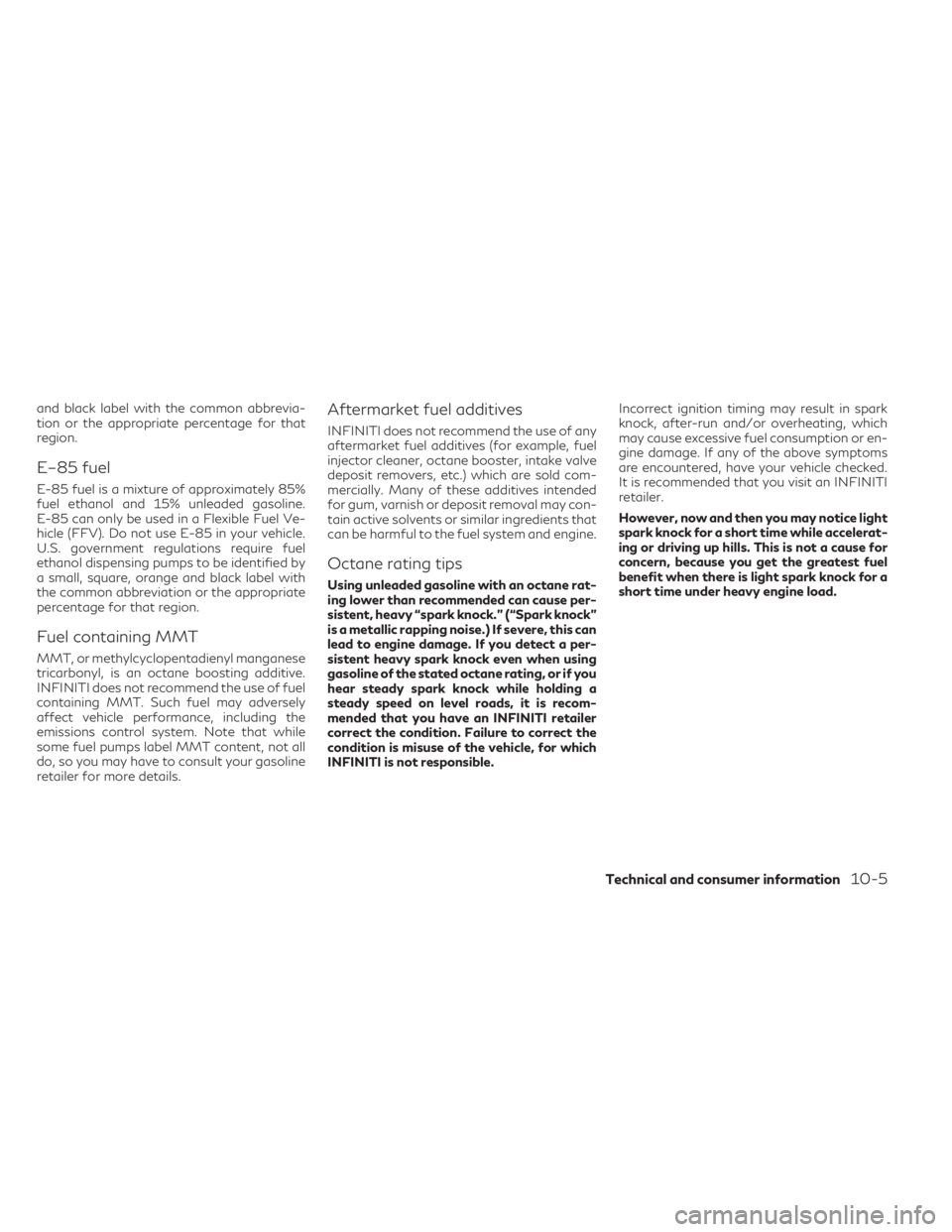
and black label with the common abbrevia-
tion or the appropriate percentage for that
region.
E–85 fuel
E-85 fuel is a mixture of approximately 85%
fuel ethanol and 15% unleaded gasoline.
E-85 can only be used in a Flexible Fuel Ve-
hicle (FFV). Do not use E-85 in your vehicle.
U.S. government regulations require fuel
ethanol dispensing pumps to be identified by
a small, square, orange and black label with
the common abbreviation or the appropriate
percentage for that region.
Fuel containing MMT
MMT, or methylcyclopentadienyl manganese
tricarbonyl, is an octane boosting additive.
INFINITI does not recommend the use of fuel
containing MMT. Such fuel may adversely
affect vehicle performance, including the
emissions control system. Note that while
some fuel pumps label MMT content, not all
do, so you may have to consult your gasoline
retailer for more details.
Aftermarket fuel additives
INFINITI does not recommend the use of any
aftermarket fuel additives (for example, fuel
injector cleaner, octane booster, intake valve
deposit removers, etc.) which are sold com-
mercially. Many of these additives intended
for gum, varnish or deposit removal may con-
tain active solvents or similar ingredients that
can be harmful to the fuel system and engine.
Octane rating tips
Using unleaded gasoline with an octane rat-
ing lower than recommended can cause per-
sistent, heavy “spark knock.” (“Spark knock”
is a metallic rapping noise.) If severe, this can
lead to engine damage. If you detect a per-
sistent heavy spark knock even when using
gasoline of the stated octane rating, or if you
hear steady spark knock while holding a
steady speed on level roads, it is recom-
mended that you have an INFINITI retailer
correct the condition. Failure to correct the
condition is misuse of the vehicle, for which
INFINITI is not responsible.Incorrect ignition timing may result in spark
knock, after-run and/or overheating, which
may cause excessive fuel consumption or en-
gine damage. If any of the above symptoms
are encountered, have your vehicle checked.
It is recommended that you visit an INFINITI
retailer.
However, now and then you may notice light
spark knock for a short time while accelerat-
ing or driving up hills. This is not a cause for
concern, because you get the greatest fuel
benefit when there is light spark knock for a
short time under heavy engine load.
Technical and consumer information10-5
Page 523 of 542
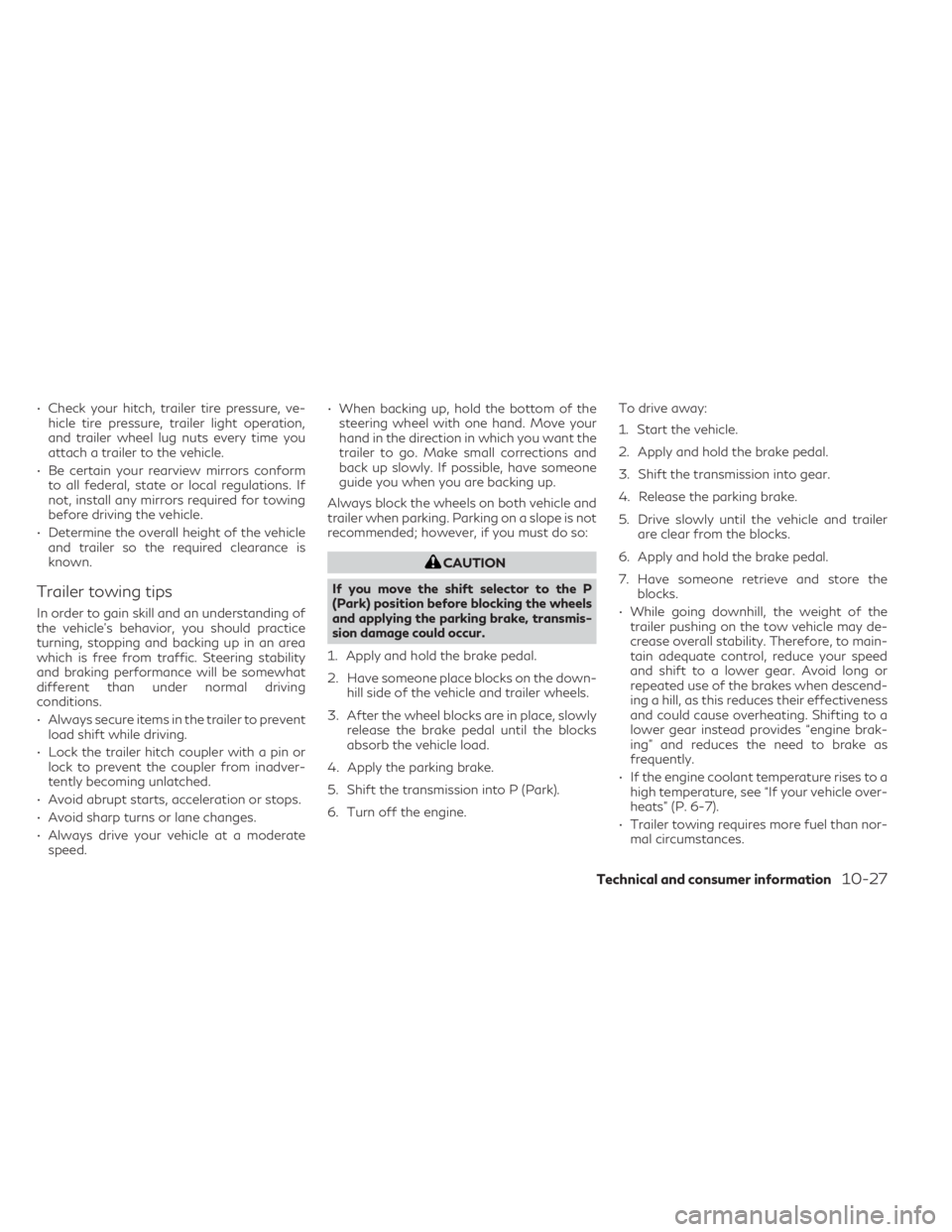
• Check your hitch, trailer tire pressure, ve-hicle tire pressure, trailer light operation,
and trailer wheel lug nuts every time you
attach a trailer to the vehicle.
• Be certain your rearview mirrors conform to all federal, state or local regulations. If
not, install any mirrors required for towing
before driving the vehicle.
• Determine the overall height of the vehicle and trailer so the required clearance is
known.
Trailer towing tips
In order to gain skill and an understanding of
the vehicle's behavior, you should practice
turning, stopping and backing up in an area
which is free from traffic. Steering stability
and braking performance will be somewhat
different than under normal driving
conditions.
• Always secure items in the trailer to preventload shift while driving.
• Lock the trailer hitch coupler with a pin or lock to prevent the coupler from inadver-
tently becoming unlatched.
• Avoid abrupt starts, acceleration or stops.
• Avoid sharp turns or lane changes.
• Always drive your vehicle at a moderate speed. • When backing up, hold the bottom of the
steering wheel with one hand. Move your
hand in the direction in which you want the
trailer to go. Make small corrections and
back up slowly. If possible, have someone
guide you when you are backing up.
Always block the wheels on both vehicle and
trailer when parking. Parking on a slope is not
recommended; however, if you must do so:
CAUTION
If you move the shift selector to the P
(Park) position before blocking the wheels
and applying the parking brake, transmis-
sion damage could occur.
1. Apply and hold the brake pedal.
2. Have someone place blocks on the down- hill side of the vehicle and trailer wheels.
3. After the wheel blocks are in place, slowly release the brake pedal until the blocks
absorb the vehicle load.
4. Apply the parking brake.
5. Shift the transmission into P (Park).
6. Turn off the engine. To drive away:
1. Start the vehicle.
2. Apply and hold the brake pedal.
3. Shift the transmission into gear.
4. Release the parking brake.
5. Drive slowly until the vehicle and trailer
are clear from the blocks.
6. Apply and hold the brake pedal.
7. Have someone retrieve and store the blocks.
• While going downhill, the weight of the trailer pushing on the tow vehicle may de-
crease overall stability. Therefore, to main-
tain adequate control, reduce your speed
and shift to a lower gear. Avoid long or
repeated use of the brakes when descend-
ing a hill, as this reduces their effectiveness
and could cause overheating. Shifting to a
lower gear instead provides “engine brak-
ing” and reduces the need to brake as
frequently.
• If the engine coolant temperature rises to a high temperature, see “If your vehicle over-
heats” (P. 6-7).
• Trailer towing requires more fuel than nor- mal circumstances.
Technical and consumer information10-27
Page 524 of 542
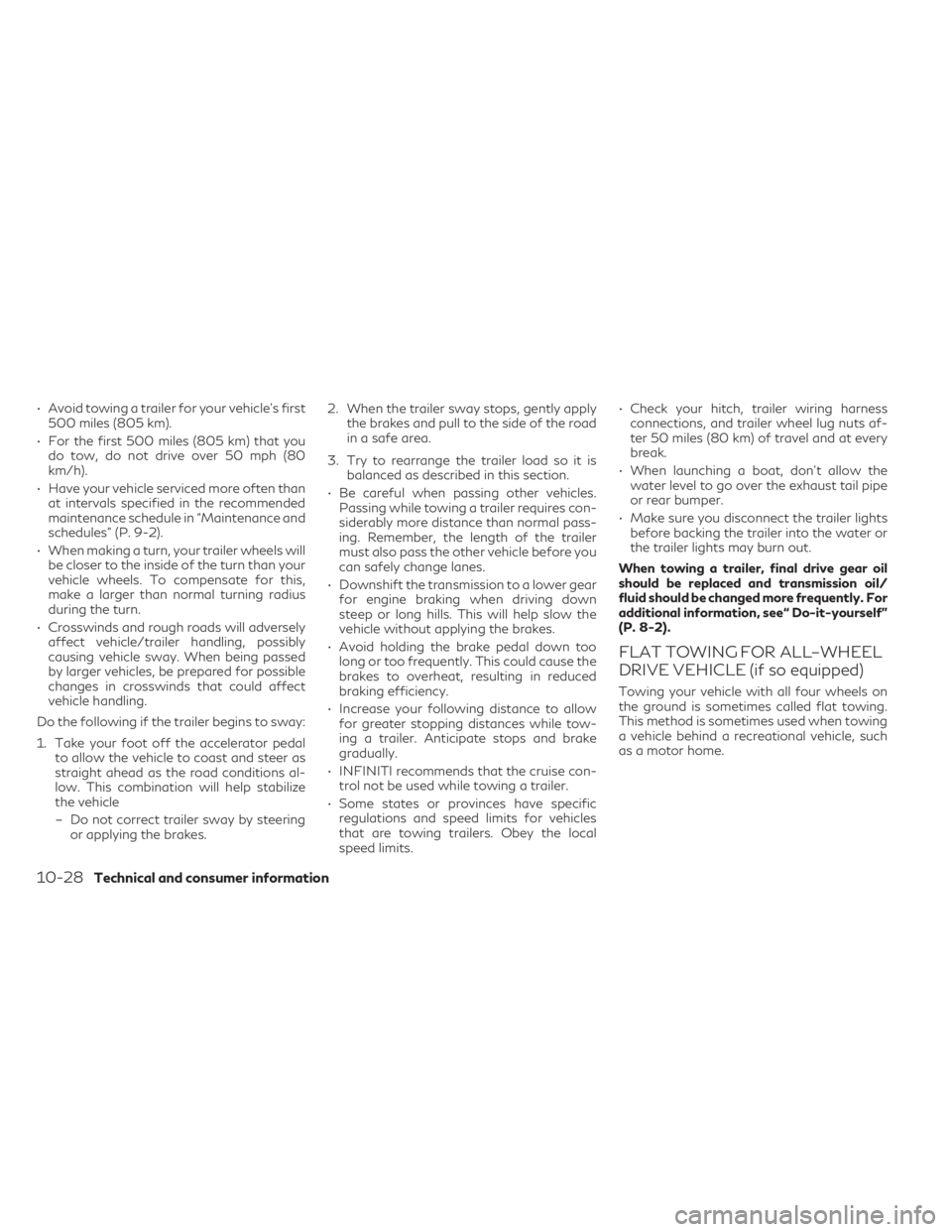
• Avoid towing a trailer for your vehicle's first500 miles (805 km).
• For the first 500 miles (805 km) that you do tow, do not drive over 50 mph (80
km/h).
• Have your vehicle serviced more often than at intervals specified in the recommended
maintenance schedule in “Maintenance and
schedules” (P. 9-2).
• When making a turn, your trailer wheels will be closer to the inside of the turn than your
vehicle wheels. To compensate for this,
make a larger than normal turning radius
during the turn.
• Crosswinds and rough roads will adversely affect vehicle/trailer handling, possibly
causing vehicle sway. When being passed
by larger vehicles, be prepared for possible
changes in crosswinds that could affect
vehicle handling.
Do the following if the trailer begins to sway:
1. Take your foot off the accelerator pedal to allow the vehicle to coast and steer as
straight ahead as the road conditions al-
low. This combination will help stabilize
the vehicle
– Do not correct trailer sway by steering or applying the brakes. 2. When the trailer sway stops, gently apply
the brakes and pull to the side of the road
in a safe area.
3. Try to rearrange the trailer load so it is balanced as described in this section.
• Be careful when passing other vehicles. Passing while towing a trailer requires con-
siderably more distance than normal pass-
ing. Remember, the length of the trailer
must also pass the other vehicle before you
can safely change lanes.
• Downshift the transmission to a lower gear for engine braking when driving down
steep or long hills. This will help slow the
vehicle without applying the brakes.
• Avoid holding the brake pedal down too long or too frequently. This could cause the
brakes to overheat, resulting in reduced
braking efficiency.
• Increase your following distance to allow for greater stopping distances while tow-
ing a trailer. Anticipate stops and brake
gradually.
• INFINITI recommends that the cruise con- trol not be used while towing a trailer.
• Some states or provinces have specific regulations and speed limits for vehicles
that are towing trailers. Obey the local
speed limits. • Check your hitch, trailer wiring harness
connections, and trailer wheel lug nuts af-
ter 50 miles (80 km) of travel and at every
break.
• When launching a boat, don't allow the water level to go over the exhaust tail pipe
or rear bumper.
• Make sure you disconnect the trailer lights before backing the trailer into the water or
the trailer lights may burn out.
When towing a trailer, final drive gear oil
should be replaced and transmission oil/
fluid should be changed more frequently. For
additional information, see“ Do-it-yourself”
(P. 8-2).
FLAT TOWING FOR ALL–WHEEL
DRIVE VEHICLE (if so equipped)
Towing your vehicle with all four wheels on
the ground is sometimes called flat towing.
This method is sometimes used when towing
a vehicle behind a recreational vehicle, such
as a motor home.
10-28Technical and consumer information
Page 528 of 542

WARNING
A vehicle equipped with All-Wheel Drive
(AWD) should never be tested using a two
wheel dynamometer (such as the dyna-
mometers used by some states for emis-
sions testing), or similar equipment. Make
sure you inform the test facility personnel
that your vehicle is equipped with AWD
before it is placed on a dynamometer. Us-
ing the wrong test equipment may result in
transmission damage or unexpected ve-
hicle movement which could result in seri-
ous vehicle damage or personal injury.
Due to legal requirements in some states and
Canadian Provinces, your vehicle may be re-
quired to be in what is called the “ready con-
dition” for an Inspection/Maintenance (I/M)
test of the emission control system.
The vehicle is set to the “ready condition”
when it is driven through certain driving pat-
terns. Usually, the ready condition can be
obtained by ordinary usage of the vehicle. If a powertrain system component is repaired
or the battery is disconnected, the vehicle
may be reset to a “not ready” condition. Be-
fore taking the I/M test, check the vehicle's
inspection/maintenance test readiness con-
dition. Place the ignition switch in the ON
position without starting the engine. If the
Malfunction Indicator Light (MIL) comes on
steady for 20 seconds and then blinks for 10
seconds , the I/M test condition is “not
ready”. If the MIL does not blink after 20
seconds, the I/M test condition is “ready”. It is
recommended that you visit an INFINITI re-
tailer to set the “ready condition” or to pre-
pare the vehicle for testing.
The ProPILOT Assist is equipped with an
Event Data Recording function.
The main purpose is to record, in certain crash
or near crash-like situations, such as an air
bag deployment or hitting a road obstacle,
data that will assist in understanding how a
vehicle’s systems performed. The Data re-
cording function is designed to record data
related to driver operation, vehicle dynamics
and system status for a short period of time.
The Data recording function in this vehicle is
designed to record such data as:
• Driver operational status of accelerator,
brake, handle etc.
• Detection status of a vehicle ahead and lane markers
• Vehicle information such as vehicle speed
• Information on the operation of the ProPI- LOT Assist
• ProPILOT Assist malfunction diagnosis information
• Images from multi-sensing front camera (Available only when SRS air bag or FEB
with Pedestrian Detection system is
activated)
The ProPILOT Assist does not record con-
versations, sounds or images of the inside of
the vehicle.
READINESS FOR INSPECTION/
MAINTENANCE (I/M) TEST EVENT DATA RECORDERS (EDR)
10-32Technical and consumer information
Page 531 of 542
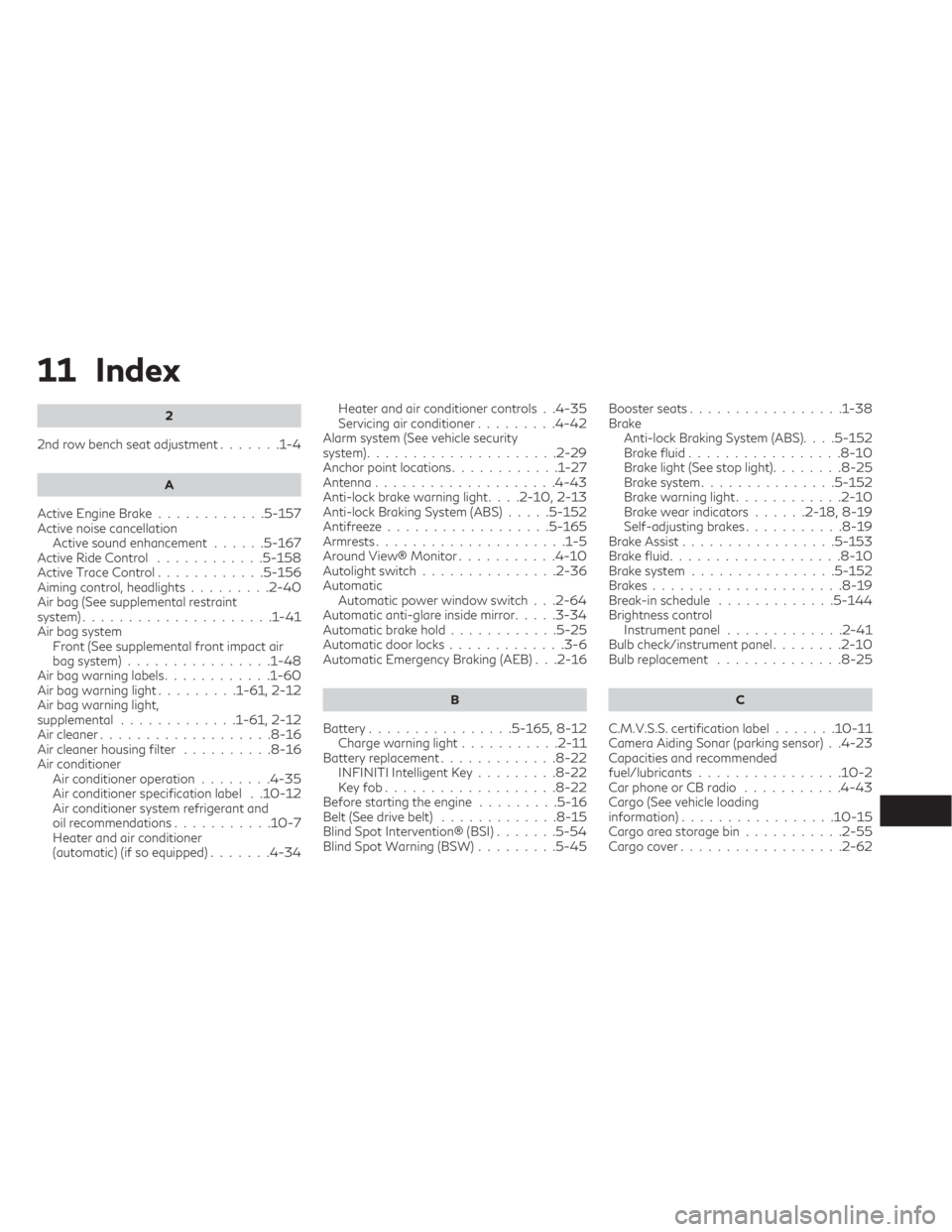
11 Index
2
2nd row bench seat adjustment.......1-4
A
Active Engine Brake............5-157Active noise cancellation
Active sound enhancement......5-167Active Ride Control........... .5-158Active Trace Control............5-156Aiming control, headlights.........2-40Air bag (See supplemental restraint
system).................... .1-41Air bag system
Front (See supplemental front impact air
bag system)
............... .1-48Air bag warning labels............1-60Air bag warning light.........1-61, 2-12Air bag warning light,
supplemental............ .1-61, 2-12Air cleaner.................. .8-16Air cleaner housing filter..........8-16Air conditioner
Air conditioner operation........4-35Air conditioner specification label. .10-12Air conditioner system refrigerant and
oil recommendations.......... .10-7Heater and air conditioner
(automatic) (if so equipped).......4-34
Heater and air conditioner controls. .4-35Servicing air conditioner.........4-42Alarm system (See vehicle security
system).................... .2-29Anchor point locations............1-27Antenna................... .4-43Anti-lock brake warning light. . . .2-10, 2-13Anti-lock Braking System (ABS).....5-152Antifreeze..................5-165Armrests.................... .1-5Around View® Monitor...........4-10Autolight switch.............. .2-36Automatic
Automatic power window switch. . .2-64Automatic anti-glare inside mirror.....3-34Automatic brake hold........... .5-25Automatic door locks............ .3-6Automatic Emergency Braking (AEB). . .2-16
B
Battery............... .5-165, 8-12Charge warning light...........2-11Battery replacement............ .8-22INFINITI Intelligent Key.........8-22Key fob.................. .8-22Before starting the engine.........5-16Belt (See drive belt).............8-15Blind Spot Intervention® (BSI).......5-54Blind Spot Warning (BSW).........5-45
Booster seats................ .1-38Brake
Anti-lock Braking System (ABS). . . .5-152Brake fluid................ .8-10Brake light (See stop light)........8-25Brake system...............5-152Brake warning light............2-10Brake wear indicators......2-18, 8-19Self-adjusting brakes...........8-19Brake Assist................ .5-153Brake fluid.................. .8-10Brake system................5-152Brakes.................... .8-19Break-in schedule.............5-144Brightness control
Instrument panel............ .2-41Bulb check/instrument panel........2-10Bulb replacement............. .8-25
C
C.M.V.S.S. certification label.......10-11Camera Aiding Sonar (parking sensor). .4-23Capacities and recommended
fuel/lubricants............... .10-2Car phone or CB radio...........4-43Cargo (See vehicle loading
information)................ .10-15Cargo area storage bin...........2-55Cargo cover................. .2-62
Page 532 of 542
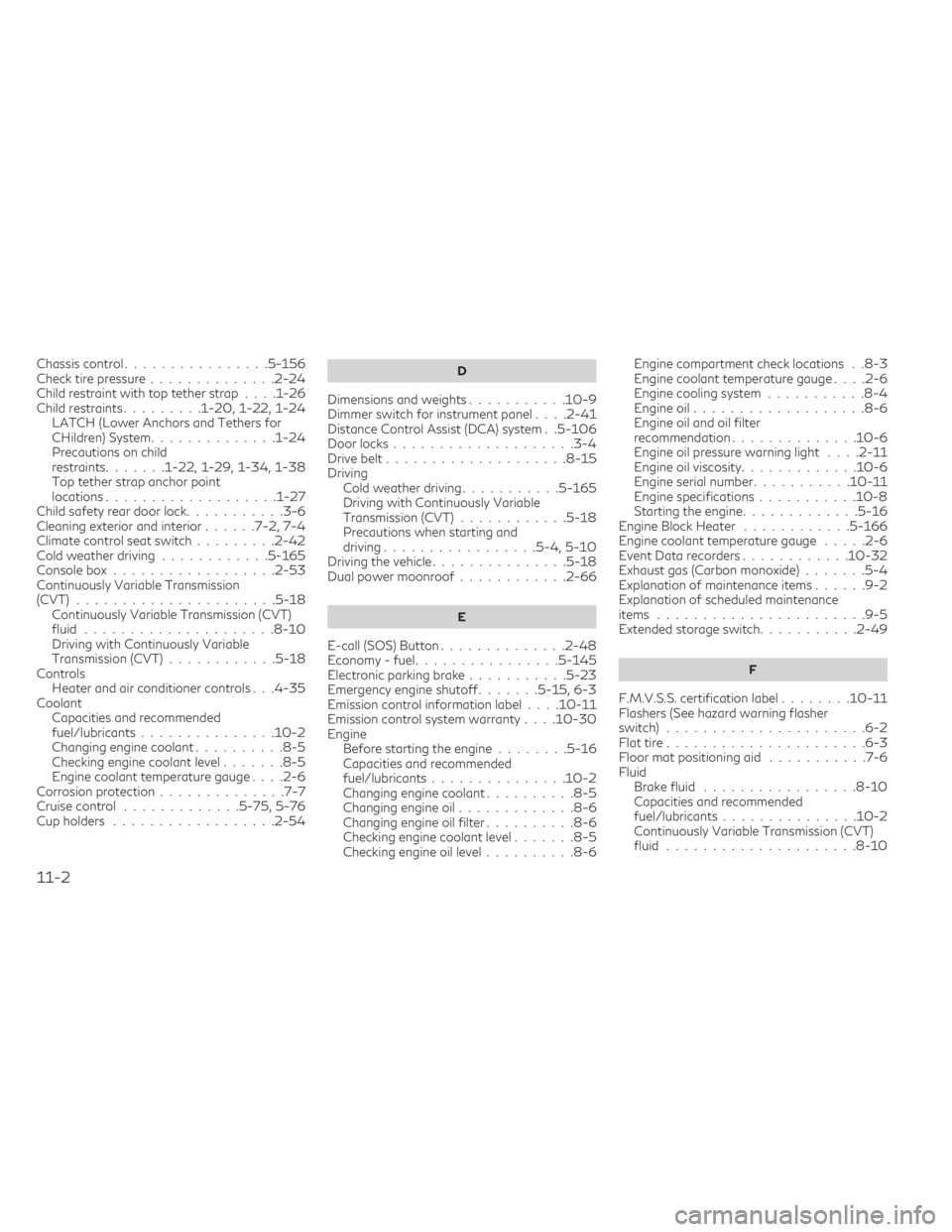
Chassis control................5-156Check tire pressure..............2-24Child restraint with top tether strap. . . .1-26Child restraints.........1-20, 1-22, 1-24LATCH (Lower Anchors and Tethers for
CHildren) System..............1-24Precautions on child
restraints.......1-22, 1-29, 1-34, 1-38Top tether strap anchor point
locations.................. .1-27Child safety rear door lock...........3-6Cleaning exterior and interior......7-2, 7-4Climate control seat switch.........2-42Cold weather driving........... .5-165Console box................. .2-53Continuously Variable Transmission
(CVT)..................... .5-18Continuously Variable Transmission (CVT)
fluid.....................8-10Driving with Continuously Variable
Transmission (CVT)............5-18Controls
Heater and air conditioner controls. . .4-35CoolantCapacities and recommended
fuel/lubricants
.............. .10-2Changing engine coolant..........8-5Checking engine coolant level.......8-5Engine coolant temperature gauge. . . .2-6Corrosion protection..............7-7Cruise control.............5-75, 5-76Cup holders................. .2-54
D
Dimensions and weights...........10-9Dimmer switch for instrument panel. . . .2-41Distance Control Assist (DCA) system. .5-106Door locks................... .3-4Drive belt....................8-15Driving
Cold weather driving.......... .5-165Driving with Continuously Variable
Transmission (CVT)........... .5-18Precautions when starting and
driving................ .5-4, 5-10Driving the vehicle...............5-18Dual power moonroof............2-66
E
E-call (SOS) Button............. .2-48Economy - fuel............... .5-145Electronic parking brake...........5-23Emergency engine shutoff.......5-15, 6-3Emission control information label. . . .10-11Emission control system warranty. . . .10-30Engine
Before starting the engine........5-16Capacities and recommended
fuel/lubricants.............. .10-2Changing engine coolant..........8-5Changing engine oil.............8-6Changing engine oil filter..........8-6Checking engine coolant level.......8-5Checking engine oil level..........8-6
Engine compartment check locations. .8-3Engine coolant temperature gauge. . . .2-6Engine cooling system...........8-4Engine oil.................. .8-6Engine oil and oil filter
recommendation..............10-6Engine oil pressure warning light. . . .2-11Engine oil viscosity.............10-6Engine serial number...........10-11Engine specifications...........10-8Starting the engine............ .5-16Engine Block Heater............5-166Engine coolant temperature gauge. . . . .2-6Event Data recorders............10-32Exhaust gas (Carbon monoxide).......5-4Explanation of maintenance items......9-2Explanation of scheduled maintenance
items...................... .9-5Extended storage switch...........2-49
F
F.M.V.S.S. certification label........10-11Flashers (See hazard warning flasher
switch)..................... .6-2Flat tire......................6-3Floor mat positioning aid...........7-6Fluid
Brake fluid................ .8-10Capacities and recommended
fuel/lubricants...............10-2Continuously Variable Transmission (CVT)
fluid.................... .8-10
11-2
Page 534 of 542
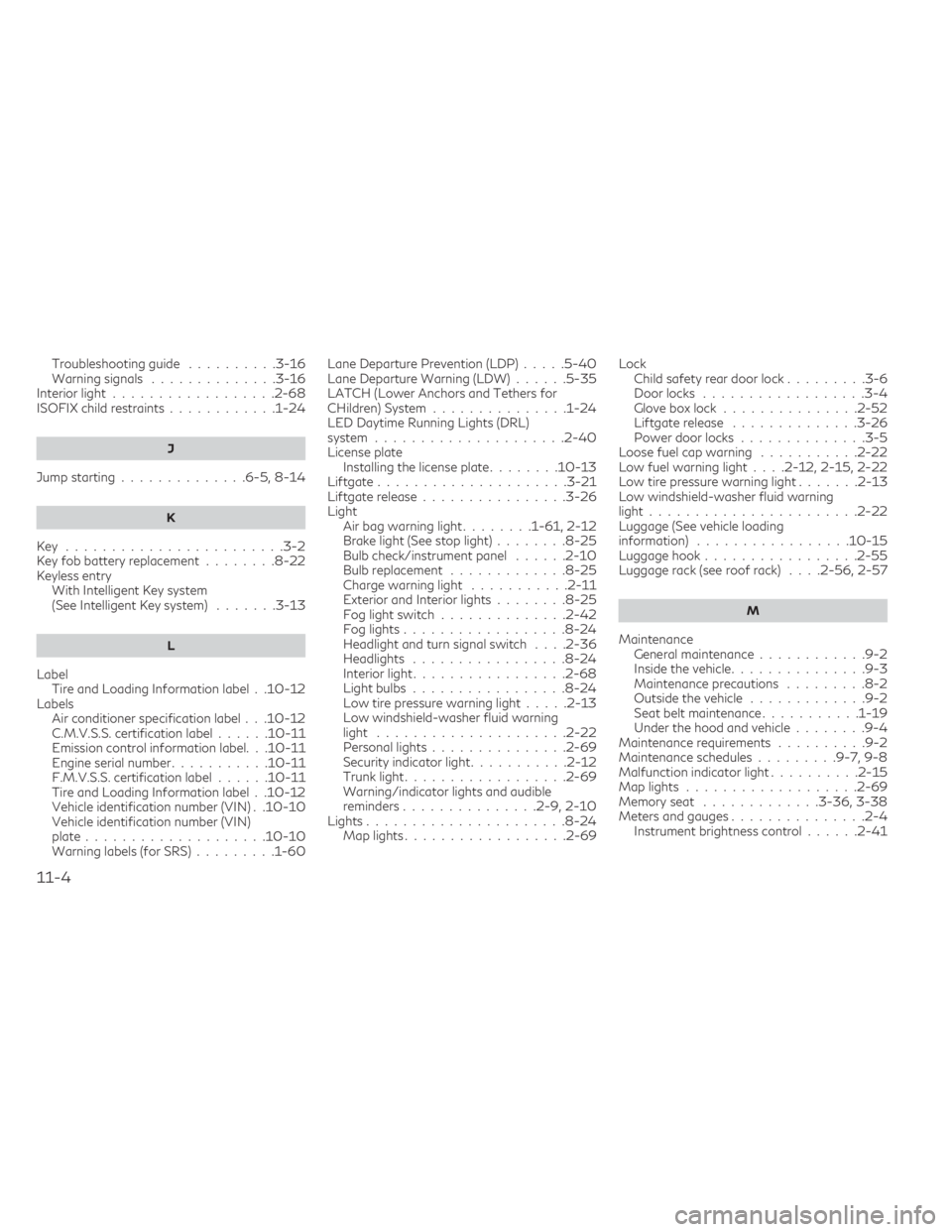
Troubleshooting guide..........3-16Warning signals..............3-16Interior light................. .2-68ISOFIX child restraints............1-24
J
Jump starting............. .6-5, 8-14
K
Key....................... .3-2Key fob battery replacement........8-22Keyless entry
With Intelligent Key system
(See Intelligent Key system)
.......3-13
L
LabelTire and Loading Information label. .10-12LabelsAir conditioner specification label. . .10-12C.M.V.S.S. certification label......10-11Emission control information label. . .10-11Engine serial number.......... .10-11F.M.V.S.S. certification label......10-11Tire and Loading Information label. .10-12Vehicle identification number (VIN). .10-10Vehicle identification number (VIN)
plate................... .10-10Warning labels (for SRS).........1-60
Lane Departure Prevention (LDP).....5-40Lane Departure Warning (LDW)......5-35LATCH (Lower Anchors and Tethers for
CHildren) System...............1-24LED Daytime Running Lights (DRL)
system.................... .2-40License plate
Installing the license plate........10-13Liftgate.................... .3-21Liftgate release................3-26Light
Air bag warning light........1-61, 2-12Brake light (See stop light)........8-25Bulb check/instrument panel......2-10Bulb replacement............ .8-25Charge warning light...........2-11Exterior and Interior lights........8-25Fog light switch............. .2-42Fog lights................. .8-24Headlight and turn signal switch. . . .2-36Headlights.................8-24Interior light.................2-68Light bulbs.................8-24Low tire pressure warning light.....2-13Low windshield-washer fluid warning
light.................... .2-22Personal lights...............2-69Security indicator light...........2-12Trunk light................. .2-69Warning/indicator lights and audible
reminders...............2-9, 2-10Lights..................... .8-24Map lights..................2-69
Lock
Child safety rear door lock.........3-6Door locks................. .3-4Glove box lock...............2-52Liftgate release..............3-26Power door locks..............3-5Loose fuel cap warning...........2-22Low fuel warning light. . . .2-12, 2-15, 2-22Low tire pressure warning light.......2-13Low windshield-washer fluid warning
light...................... .2-22Luggage (See vehicle loading
information).................10-15Luggage hook.................2-55Luggage rack (see roof rack). . . .2-56, 2-57
M
Maintenance
General maintenance........... .9-2Inside the vehicle.............. .9-3Maintenance precautions.........8-2Outside the vehicle.............9-2Seat belt maintenance...........1-19Under the hood and vehicle........9-4Maintenance requirements..........9-2Maintenance schedules.........9-7, 9-8Malfunction indicator light..........2-15Map lights.................. .2-69Memory seat.............3-36, 3-38Meters and gauges.............. .2-4Instrument brightness control......2-41
11-4
Page 535 of 542
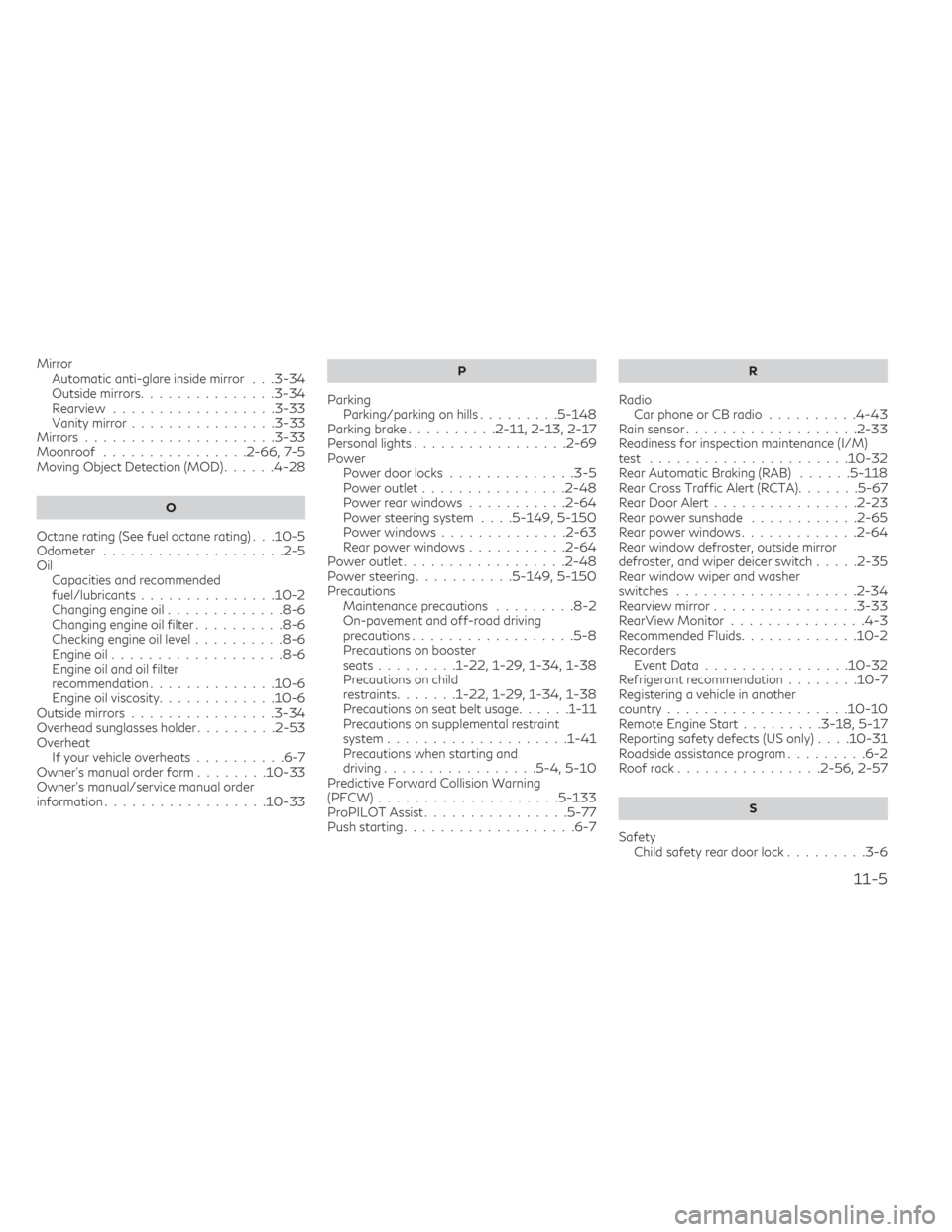
MirrorAutomatic anti-glare inside mirror. . .3-34Outside mirrors.............. .3-34Rearview................. .3-33Vanity mirror................3-33Mirrors.................... .3-33Moonroof................2-66, 7-5Moving Object Detection (MOD)......4-28
O
Octane rating (See fuel octane rating). . .10-5Odometer................... .2-5Oil
Capacities and recommended
fuel/lubricants
.............. .10-2Changing engine oil.............8-6Changing engine oil filter..........8-6Checking engine oil level..........8-6Engine oil.................. .8-6Engine oil and oil filter
recommendation..............10-6Engine oil viscosity.............10-6Outside mirrors............... .3-34Overhead sunglasses holder.........2-53Overheat
If your vehicle overheats..........6-7Owner's manual order form........10-33Owner's manual/service manual order
information................. .10-33
P
Parking
Parking/parking on hills.........5-148Parking brake..........2-11, 2-13, 2-17Personal lights................ .2-69Power
Power door locks............. .3-5Power outlet............... .2-48Power rear windows...........2-64Power steering system. . . .5-149, 5-150Power windows............. .2-63Rear power windows...........2-64Power outlet................. .2-48Power steering...........5-149, 5-150Precautions
Maintenance precautions.........8-2On-pavement and off-road driving
precautions................. .5-8Precautions on booster
seats.........1-22, 1-29, 1-34, 1-38Precautions on child
restraints.......1-22, 1-29, 1-34, 1-38Precautions on seat belt usage......1-11Precautions on supplemental restraint
system................... .1-41Precautions when starting and
driving.................5-4, 5-10Predictive Forward Collision Warning
(PFCW)................... .5-133ProPILOT Assist................5-77Push starting.................. .6-7
R
Radio
Car phone or CB radio..........4-43Rain sensor.................. .2-33Readiness for inspection maintenance (I/M)
test..................... .10-32Rear Automatic Braking (RAB)......5-118Rear Cross Traffic Alert (RCTA).......5-67Rear Door Alert................2-23Rear power sunshade............2-65Rear power windows............ .2-64Rear window defroster, outside mirror
defroster, and wiper deicer switch.....2-35Rear window wiper and washer
switches................... .2-34Rearview mirror................3-33RearView Monitor...............4-3Recommended Fluids.............10-2Recorders
Event Data............... .10-32Refrigerant recommendation........10-7Registering a vehicle in another
country................... .10-10Remote Engine Start.........3-18, 5-17Reporting safety defects (US only). . . .10-31Roadside assistance program.........6-2Roof rack................2-56, 2-57
S
Safety
Child safety rear door lock.........3-6
11-5